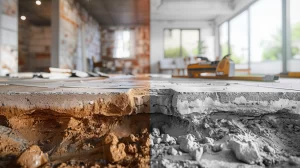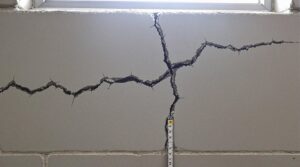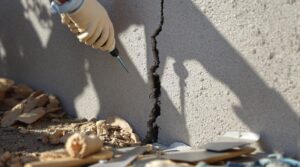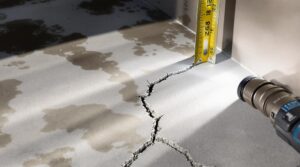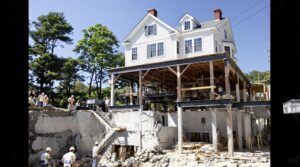A detailed guide to basement foundation repairs and costs helps homeowners identify and address structural issues. Common problems arise from hydrostatic pressure, sump pump failure, and poor grading. Various foundation cracks indicate different causes, from construction defects to environmental factors. To determine the most effective and cost-efficient repair method, understanding the types of cracks and their causes is essential. Exploring the complexities of basement foundation repairs and costs will further inform effective solutions and long-term prevention strategies.
Key Takeaways
- Basement foundation repairs typically range from $2,300 to $7,600, with cost influenced by foundation type and damage extent.
- Signs of foundation damage include cracks in walls and floors, sticking doors/windows, and water seepage.
- Understanding causes of foundation damage, such as hydrostatic pressure and poor grading, is essential for effective repairs.
- Regular inspections and maintenance strategies, like moisture management and drainage system upkeep, help prevent costly repairs.
- Different repair methods, such as concrete piers and polyurethane foam jacking, vary in cost and effectiveness, requiring professional evaluation.
Common Basement Issues and Their Causes
Basement foundations are susceptible to various issues that can compromise their integrity and the overall safety of the structure. Hydrostatic pressure, sump pump failure, and interior water sources are common causes of basement water problems.
Poor grading, defective gutters and downspouts, and foundation settling can also lead to water accumulation and structural damage. Conducting a thorough foundation inspection checklist can help identify potential issues before they become major problems.
Regular assessments can inform the implementation of effective basement waterproofing solutions. Understanding the causes of common basement issues is essential for maintaining the structural integrity and overall safety of the foundation, allowing homeowners to take proactive measures to prevent costly repairs and guarantee a dry, healthy, and secure living space. Cracks in the foundation can allow water to seep into the home, further exacerbating existing problems.
Types of Basement Foundation Cracks
Types of basement foundation cracks vary in their implications for structural integrity.
Understanding the distinctions between common crack types, such as vertical, horizontal, diagonal, stair-step, and shrinkage cracks, is vital for determining the necessary course of action.
Identifying the underlying causes of these cracks is essential for addressing the root issues and preventing further damage to the foundation. Regular inspections can help detect hairline cracks before they worsen and lead to significant problems.
Common Crack Types Explained
While it is common for cracks to appear in a foundation due to normal settling, they can be a sign of more significant problems. Various crack types can affect a foundation's stability, necessitating crack repair.
Vertical foundation cracks are typically cosmetic and often settle over time. However, horizontal foundation cracks can indicate more severe issues, such as soil pressure or water damage, and require immediate attention from a specialist.
Diagonal cracks suggest uneven settlement, while stair-step cracks, common in masonry walls, follow the joints between bricks or blocks and indicate movement.
Each crack type requires professional assessment to determine the necessary repair method and guarantee the foundation's stability and integrity. Proper identification is vital in addressing foundation issues and applying effective solutions. Understanding the causes of foundation cracks, such as poor soil compaction, is crucial for prevention and management of foundation problems.
Identifying Foundation Crack Causes
Foundation cracks can be symptoms of underlying issues, ranging from construction defects to environmental factors.
Construction issues, such as poor soil compaction, can cause uneven settlement and foundation damage. Environmental factors, including drought, excessive moisture, and extreme heat, can also contribute to foundation cracks. Expansive soils, which expand and shrink with moisture changes, can lead to structural problems.
To identify the cause of foundation cracks, it is essential to take into account factors such as soil type, drainage, and weather patterns. Effective solutions, including soil stabilization techniques and moisture control strategies, can help prevent further damage.
A professional evaluation is necessary to diagnose and address foundation cracks accurately, and regular checks can help prevent costly structural damage and safety hazards.
Signs of Foundation Damage and When to Act
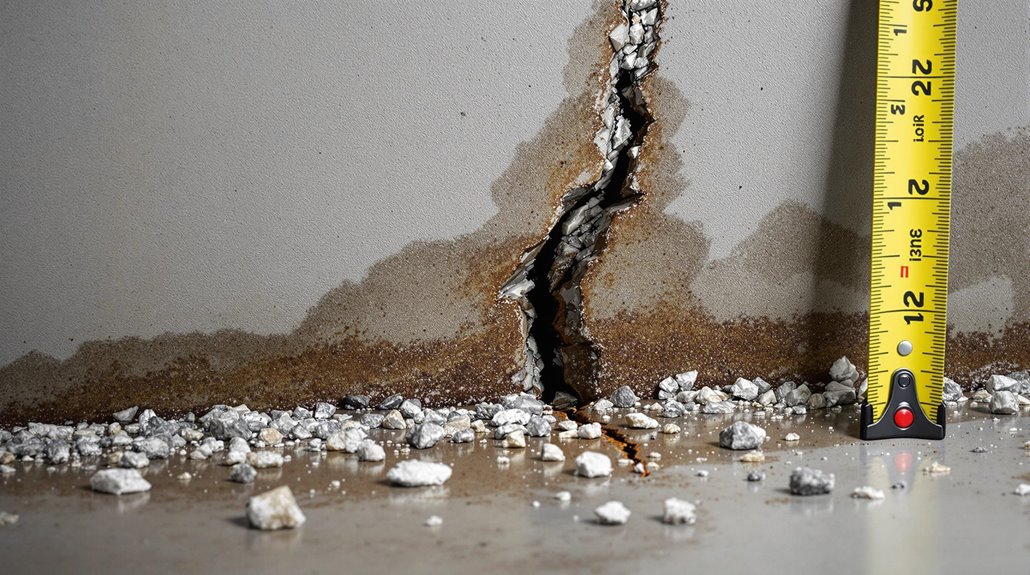
What are the warning signs that a basement foundation is in distress?
Foundation settlement indicators include cracks in walls and floors, sticking doors and windows, uneven floors, and gaps in floors, walls, doors, or windows.
Exterior signs of foundation damage include cracks in exterior brick or stonework, leaning or cracked chimneys, bowing basement walls, and gaps around doors and windows.
Emergency repair signs, such as water seepage in the basement, separation of building elements, and severe wall cracks, require immediate attention.
It is essential to recognize these signs to prevent further damage and costly repairs. Ignoring foundation issues can lead to increased energy bills, further structural damage, mold growth, and potentially, foundation collapse.
Early detection and repair can prevent these consequences.
Basement Repair Methods and Techniques
Employing a range of specialized techniques, basement repair experts can effectively restore a damaged foundation to its original stability and functionality.
Underpinning techniques involve strengthening an existing foundation by extending its depth and breadth, often using piers and beams. Piering methods, such as helical piers, utilize large piers that screw into the soil to lift the foundation. Concrete pressed piles are also used to provide a stable support base.
Additionally, polyurethane foam jacking is utilized to fill gaps in the concrete or underlying soil to stabilize the foundation. These techniques can be applied to various foundation types, including slab foundations, and can provide a permanent solution to foundation problems.
Choosing the Right Foundation Repair Method
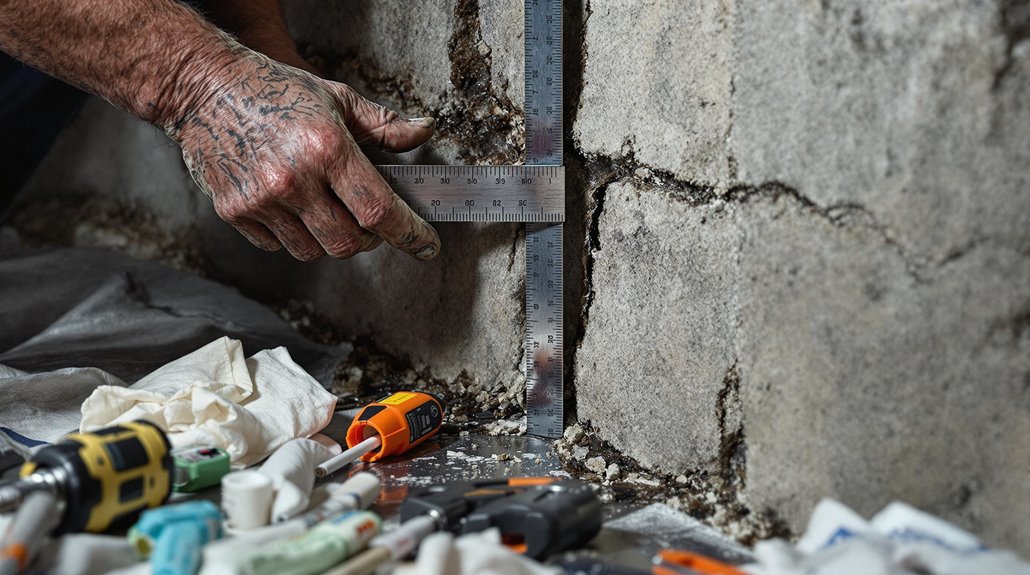
How does one determine the most effective approach for repairing a damaged basement foundation? A thorough repair method evaluation is essential, taking into account the severity of damage and soil condition impact.
Minor cracks may be addressed with slab jacking or epoxy injection, while severe problems often require underpinning methods like steel piers or helical piers.
Soil conditions should be evaluated, as they affect repair method effectiveness. Water intrusion issues might require methods like waterproofing and drainage solutions.
A professional assessment is necessary to determine the best repair approach, considering factors such as budget constraints, future plans for the home, and local regulations.
Understanding Foundation Repair Costs and Estimates
Numerous factors contribute to the complexity of determining foundation repair costs, making it essential for homeowners to understand the variables involved in estimating the expenses associated with basement foundation repairs.
Among these variables, the type of foundation and extent of damage have a significant impact on the overall cost. Basement foundations tend to fall within the $2,300 to $7,600 range.
The choice of repair techniques, such as polyurethane foam injection or piering, can also influence the total cost.
Accurate cost estimation requires professional evaluations, home inspections, and structural engineer reports.
Understanding the cost factors and obtaining thorough assessments from professionals can help homeowners navigate the complex process of foundation repair and develop realistic budgets for their projects.
Factors That Affect Foundation Repair Costs

The cost of foundation repairs is influenced by various factors, including the type of foundation used, which can affect the complexity and cost of repairs.
Repair methods and materials also play a significant role in determining costs, as different techniques and products are suited to specific foundation types and issues.
Labor and access issues, such as the need for specialized equipment or difficult site conditions, can further impact the overall cost of foundation repairs.
Type of Foundation Used
Foundation type plays a crucial role in determining the overall cost of repairs. Different foundation types have distinct repair needs and costs.
Slab foundations require slabjacking or mudjacking, while pier and beam foundations need underpinning or piering for settling issues.
Crawl space foundations may require specialized repairs due to their unique construction, and basement foundations often need wall anchors or braces for bowing or leaning walls.
Each foundation type has its own set of repair implications, with varying levels of complexity and cost.
Concrete slab foundations are generally less expensive to repair, while pier and beam foundations require more extensive repairs due to their complex structure.
Understanding the specific foundation type and its repair implications is essential for accurate cost estimation. Different foundation types, such as slab, crawl space, or basement foundations, each have unique characteristics that affect not only their integrity but also the methods used to repair them. For instance, a foundation with a history of settling may require different solutions compared to one that primarily suffers from water damage. Exploring foundation leak repair options is critical for addressing these issues effectively, ensuring that homeowners can make informed decisions while budgeting for necessary repairs.
Repair Methods and Materials
Repairing a damaged foundation requires a thorough understanding of the various methods and materials available, as each has its own strengths, limitations, and cost implications.
Different foundation materials and repair techniques can greatly impact the overall cost and effectiveness of the repair. The following are common repair methods:
- Concrete Piers: Drilling cylindrical holes below the foundation to pour liquid concrete, suitable for pier and beam houses and concrete slab foundations.
- Polyurethane Foam Jacking: Injecting polyurethane foam to lift and support sunken concrete slab foundations, effective for filling voids in the foundation or underlying soil structure.
- Pressed Concrete Pilings: Driving pilings deep for interior and exterior repairs, providing durable support for foundations.
- Specialized Repair Considerations: Addressing expansive soils, seismic activity, and age-related deterioration requires specialized expertise and equipment.
Labor and Access Issues
While various repair methods and materials can greatly impact the overall cost of foundation repairs, labor and access issues are equally important factors that can make or break a project's budget.
Local labor rates, skilled labor availability, and cost of living can greatly influence labor costs. In addition, access challenges such as site accessibility, obstacles, and soil conditions can complicate repairs, increasing labor costs and time requirements.
Property size and layout also play a critical role, as larger properties and complex layouts can require more materials and labor.
Moreover, geographic and regulatory factors, including local building codes and environmental regulations, can impact labor costs and access challenges.
Accurately evaluating these factors is essential to determine the total cost of foundation repairs.
The Importance of Early Detection and Prevention
Historically, homes have been subject to a myriad of structural issues, many of which stem from the foundation.
Early detection and prevention of foundation problems can greatly reduce the risk of costly repairs and safety hazards. To mitigate these risks, homeowners should implement early intervention strategies, including proactive foundation monitoring.
Key steps in this process include:
- Regular inspections: Conduct thorough inspections of the foundation to identify cracks, gaps, and water damage.
- Proper drainage: Guarantee proper drainage around the home to prevent water from pooling near the foundation.
- Landscaping and soil contours: Ensure the ground around the building slopes away to prevent water from pooling near the foundation.
- Gutter and downspout maintenance: Regularly maintain gutters and downspouts to prevent water from seeping into the foundation.
DIY Foundation Repair vs. Hiring a Professional
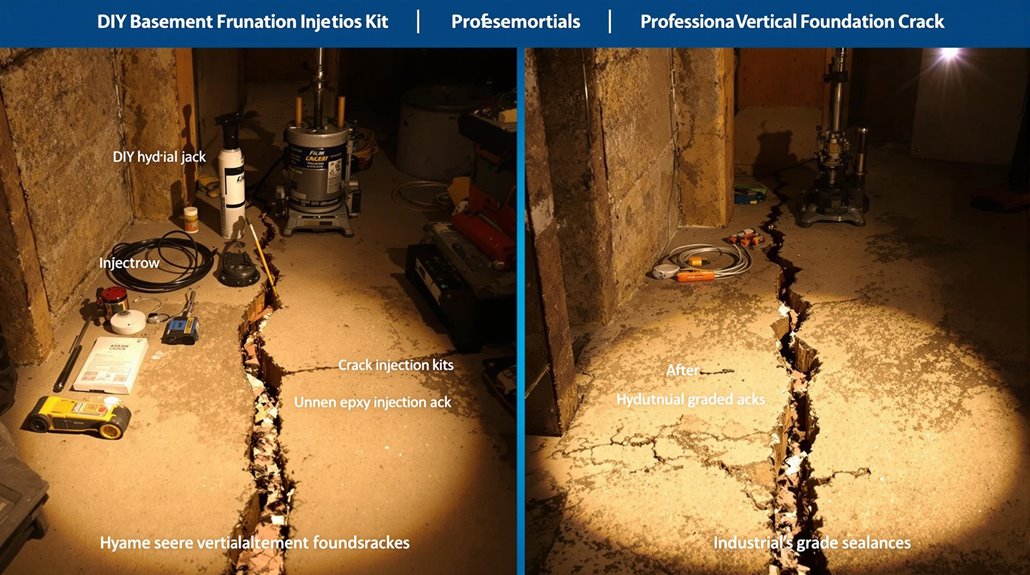
When confronted with foundation issues, homeowners are often faced with a critical decision: whether to attempt a DIY repair or hire a professional.
Opting for a DIY approach poses significant risks, including increased structural damage, inaccurate diagnosis, and safety hazards. Without proper equipment and expertise, DIY attempts can worsen existing problems, leading to costly repairs in the future.
In contrast, hiring a professional provides numerous benefits, including expertise and experience, quality and safety, and warranty and peace of mind.
Professionals can accurately identify and address foundation issues, preventing minor problems from becoming catastrophic failures. By choosing a professional, homeowners can guarantee long-term cost savings and avoid the pitfalls associated with DIY risks, ultimately protecting their home's safety and integrity.
How to Prevent Foundation Damage and Reduce Costs
To prevent foundation damage and reduce costs, homeowners should prioritize regular inspections of their home's foundation and overall structure.
Proper drainage systems must be maintained to prevent water accumulation, with components such as gutters, downspouts, and ground drains functioning as intended to direct water away from the foundation.
Addressing issues promptly through necessary repairs or modifications can mitigate the risk of more severe damage and costly repairs.
Inspect Your Home Regularly
How often do homeowners inspect their properties for signs of foundation damage? Foundation inspection tips stress the importance of routine checks to prevent costly repairs.
Regular inspections can identify potential issues before they become major problems.
Some key areas to focus on during inspections include:
- Exterior foundation walls: Look for cracks, shifts, or bulging, especially around corners, windows, and doors.
- Interior signs of foundation damage: Check for cracks in floors, walls, and ceilings, as well as uneven or sloping floors.
- Basement and crawl space conditions: Inspect for dampness, water stains, mold, and signs of pest infestation.
- Seasonal and professional considerations: Pay attention to changes during extreme weather conditions and consider hiring a professional for annual inspections.
Maintain Proper Drainage Systems
Because foundation damage can be a costly and time-consuming issue to resolve, maintaining proper drainage systems is essential for preventing damage and reducing costs.
Drainage systems alleviate hydrostatic pressure by diverting water away from foundation walls, maintaining balanced soil moisture levels and preventing soil erosion. Effective drainage system installation, including the use of footing drains, French drains, and sump pumps, helps to remove water that accumulates around the foundation.
Additionally, effective grading techniques are vital for directing water away from the foundation. By implementing these systems and techniques, homeowners can reduce the risk of foundation cracks and damage, prevent moisture accumulation, and maintain the structural integrity of the foundation, ultimately saving on costly repairs and extending the lifespan of the foundation.
Address Issues Promptly
While regular inspections and maintenance are crucial for preventing foundation damage, addressing issues promptly is equally essential for mitigating the risk of costly repairs and ensuring the long-term stability of the foundation.
Effective foundation monitoring and moisture control are key components of a proactive approach to foundation maintenance.
To address issues promptly and prevent further damage:
- Conduct Seasonal Checks: Regularly inspect the foundation for signs of damage or deterioration, addressing any issues promptly to prevent escalation.
- Implement Corrective Actions: Take swift action to correct any foundation issues, using high-quality products and structural support where necessary.
- Assess Foundation Type: Consider the specific type of foundation and choose repair methods and materials accordingly.
- Prioritize Prompt Repairs: Address minor issues before they become major problems, mitigating damage and reducing long-term costs.
Basement Foundation Repair Options and Solutions
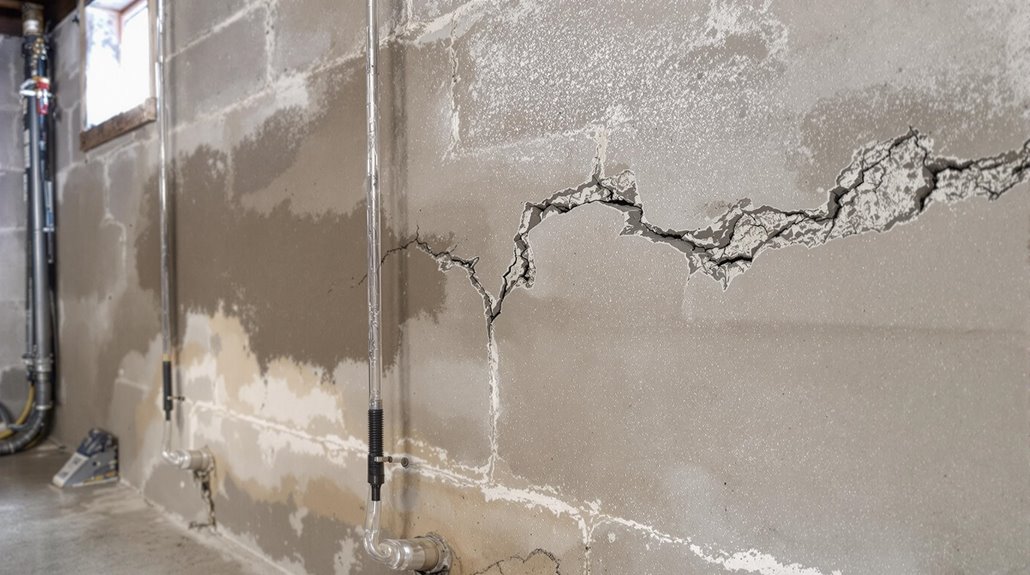
Numerous basement foundation repair options and solutions are available to rectify damage, deterioration, and instability in residential basements.
Based on foundation stability assessments, homeowners can select suitable basement repair technologies.
For bowing walls, options include wall plate anchors, helical tieback anchors, C-channel anchors, Invisibeam carbon fiber straps, and steel reinforcement.
Crack repair solutions encompass carbon fiber staples, epoxy crack injection, patch and seal, concrete patching, and sealant application.
Settlement issues can be addressed using steel push piers, helical piers, drilled concrete piers, screw jacks, and underpinning piers.
In severe cases, foundation replacement solutions such as sister foundations, foundation replacement, jack and lift, pile-supported underpinning, and complete foundation overhaul may be necessary.
Each solution aims to restore stability and prevent further damage.
Maintenance and Upkeep for a Healthy Basement Foundation
A well-maintained basement foundation is imperative for preventing damage, deterioration, and instability in residential basements.
To guarantee the longevity of a basement foundation, it's essential to implement regular maintenance and upkeep measures. Foundation monitoring and moisture control are fundamental components of a healthy basement foundation.
Key maintenance strategies include:
- Regular inspections: Conduct regular checks for cracks, shifts, and water damage to identify potential issues early.
- Moisture management: Redirect water away from the foundation and maintain consistent moisture levels to prevent soil expansion and contraction.
- Drainage system maintenance: Confirm gutters are clean and direct water away from the foundation to mitigate water-related issues.
- Soil stabilization: Consider techniques to prevent foundation settlement and guarantee the stability of the surrounding soil.
Frequently Asked Questions
Can I Sell a House With Foundation Problems?
A house with foundation issues can be sold, but steering through the process requires careful consideration of selling strategies, including transparency in disclosure, pricing adjustments, and potentially repairing issues to increase the home's value.
How Long Does a Foundation Repair Take to Complete?
The foundation repair timeline varies depending on the project's complexity, with most repairs taking a few hours to several days to complete, while extensive damage or unforeseen contingencies can prolong the project duration considerably.
Will Foundation Repair Increase My Property Value?
Foundation repair can increase a property's value by resolving structural issues, enhancing aesthetic appeal, and providing buyers with peace of mind, ultimately yielding repair benefits that translate to a higher foundation value and selling price.
Can I Finance Foundation Repairs or Get a Loan?
Maneuvering foundation repair options can be a financial maze, but various financing solutions can provide a lifeline, including home equity loans, personal loans, credit card financing, and government-sponsored loans and grants.
Are Foundation Repairs Covered by Homeowner's Insurance?
Foundation repairs are partially covered by homeowner's insurance, varying by policy and provider. Insurance coverage applies to specific, sudden perils, while repair exclusions include gradual wear, flooding, and construction issues, as detailed in individual policies.
